First off, let me apologize for the late start on this series. I’ve been riding herd on a number of projects for SWC, the foremost right now being overseeing the final touches on our King Kong e-book (coming March 7!). But now that things are back on track, let’s talk about Carmilla!
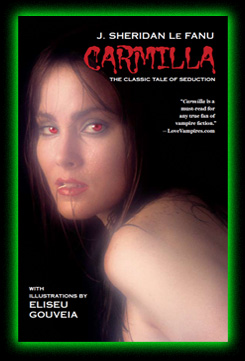 One hundred and forty-five years ago, J. Sheridan Le Fanu’s classic vampire tale, Carmilla, debuted in serialized form in the pages of the magazine Dark Blue—running from the December 1871 issue through March 1872—and was then reprinted in Le Fanu’s short story collection, In a Glass Darkly, published later that year.
One hundred and forty-five years ago, J. Sheridan Le Fanu’s classic vampire tale, Carmilla, debuted in serialized form in the pages of the magazine Dark Blue—running from the December 1871 issue through March 1872—and was then reprinted in Le Fanu’s short story collection, In a Glass Darkly, published later that year.
If you’re unfamiliar with what’s probably Le Fanu’s most famous work, here’s the back-cover copy from the edition that we published in 2010, which has become the most popular title in our Illustrated Classics line:
Before Edward and Bella, before Lestat and Louis, even before Dracula and Mina, there was the vampiric tale of Carmilla and Laura.
Living with her widowed father in a dreary old castle in the woods of Styria, Laura has longed to have a friend with whom she can confide; a friend to bring some excitement to her pastoral lifestyle. And then Carmilla enters her life.
Left by her mother in the care of Laura’s father, Carmilla is young, beautiful, playful—everything that Laura had hoped to find in a companion. In fact, the lonely girl is so thrilled to have a new friend that she is willing to overlook the dark-haired beauty’s strange actions…which include a disturbing, growing obsession for her lovely hostess.
Carmilla, it seems, desires more than just friendship from Laura….
The influence of Carmilla on horror fiction has lasted to this day, serving as an inspiration for numerous writers—including Bram Stoker in the creation of the vampire brides who threaten Jonathan Harker in Stoker’s seminal novel, Dracula. Carmilla has also been an inspiration for filmmakers, its lesbian-vampire theme being fully exploited in such adaptations as Hammer Films’ The Vampire Lovers and director Roger Vadim’s Blood and Roses.
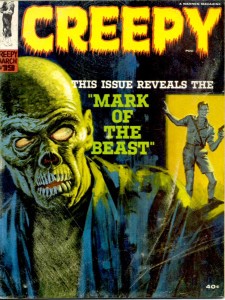 In recognition of Carmilla’s anniversary, we’re examining some of those adaptations. Today, though, we’ll be taking a look at one that’s not on film, but paper—specifically the one that first appeared in Warren Publishing’s Creepy #19 (cover-dated March 1968).
In recognition of Carmilla’s anniversary, we’re examining some of those adaptations. Today, though, we’ll be taking a look at one that’s not on film, but paper—specifically the one that first appeared in Warren Publishing’s Creepy #19 (cover-dated March 1968).
According to The Warren Companion (David A. Roach and Jon Cooke, eds.; TwoMorrows Publishing, 2001) and Horror Comics in Black and White: A History and Catalog, 1964–2004 (Richard J. Arndt, author; McFarland & Company, Inc., 2013), the twenty-page adaptation was originally done for a short-lived series (as in, only one volume was published) called Christopher Lee’s Treasury of Terror, packaged by former Warren editor Russ Jones. When the series was canceled, Warren picked up the project.
Below are the first four pages. As the saying goes, click to embiggen the images.
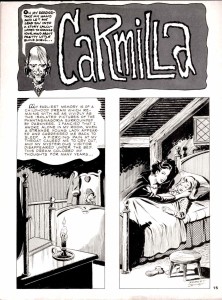
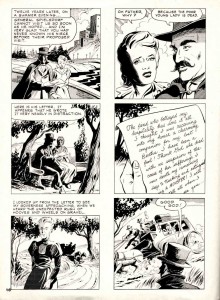
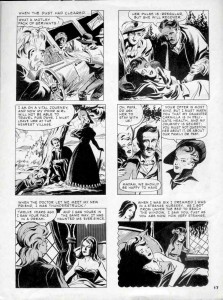
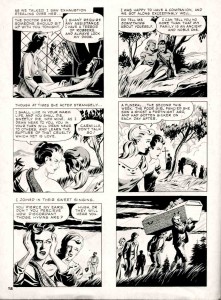 Writer John Benson and artist Robert Jenney present a fairly straightforward adaptation, but overall it’s a pretty dry translation, lacking the disturbing intensity of Carmilla’s interest in Laura and squeezing the storytelling into six-panel grids that force most of the art to be close-ups and mid-shots of the characters; I imagine the latter was done to accommodate its intended spot in the canceled Treasury of Terror. And, little surprise given the time of its publication, the comic version skims the sexual undertones to focus more on Carmilla’s vampiric habits. There are some indications in her talks with Laura that she considers the girl more than a friend (“I shall live in your warm life and you shall die, sweetly die, into mine.”), but without a greater focus on the girls’ relationship—and Laura’s growing realization that her new friend’s weirdly passionate speeches are starting to freak her out—it just comes across as standard vampire-to-victim wordplay.
Writer John Benson and artist Robert Jenney present a fairly straightforward adaptation, but overall it’s a pretty dry translation, lacking the disturbing intensity of Carmilla’s interest in Laura and squeezing the storytelling into six-panel grids that force most of the art to be close-ups and mid-shots of the characters; I imagine the latter was done to accommodate its intended spot in the canceled Treasury of Terror. And, little surprise given the time of its publication, the comic version skims the sexual undertones to focus more on Carmilla’s vampiric habits. There are some indications in her talks with Laura that she considers the girl more than a friend (“I shall live in your warm life and you shall die, sweetly die, into mine.”), but without a greater focus on the girls’ relationship—and Laura’s growing realization that her new friend’s weirdly passionate speeches are starting to freak her out—it just comes across as standard vampire-to-victim wordplay.
A minor head scratcher is that in Le Fanu’s text, Laura narrates the story as she recounts her terrifying encounter with Carmilla to what appears to be a psychiatrist—the novella opens with a note explaining that what follows is a transcript of Laura’s sessions—but halfway through the comic version the focus is put on General Spielsdorf, a friend of Laura’s father’s and the distraught parent whose daughter was Carmilla’s previous victim. With Le Fanu, Laura ends her account by saying that she sometimes imagines hearing Carmilla’s footsteps in the hallway; in the comic, Uncle Creepy remarks that it’s the general who often hears this. An odd decision on Benson’s part, since it suddenly relegates Laura to a lesser role in her own story.
If you’re interested in checking out the rest of this adaptation, “Carmilla” can be found in the hardcover collection Creepy, Volume 4, published by Dark Horse Comics.
Coming Sunday: Grab a bucket of popcorn, a box of Jujubes, and a giant-size soda because we’re off to the movies! Carmilla makes the jump to the big screen in the form of scream queen Ingrid Pitt, in Hammer Films’ production of The Vampire Lovers. If the Creepy comic adaptation merely skimmed the surface of the lesbian-vampire aspects found in Le Fanu’s tale, this 1970 film jumps in with both feet—and brings veteran vampire slayer Peter Cushing along for a swim! See you Sunday!
Carmilla—the SWC Illustrated Classics edition, which features six original drawings by Eliseu Gouveia (Lorelei: Sects and the City, The Saga of Pandora Zwieback Annual #1)—is available in print and digital formats from our webstore, so visit its product page for ordering information.


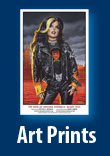




Pingback: StarWarp Concepts Looks at a Creepy Carmilla Adaptation | The Saga of Pandora Zwieback